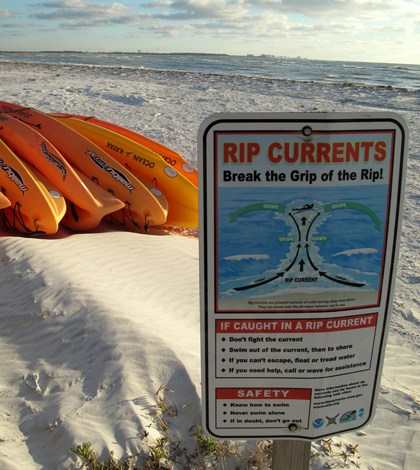New model uses off-the-shelf technology to forecast rip currents

Rip currents chronically threaten beach-goers, but a new mathematical model in development may give the sunbaked and sandy notification of swirling tides before they dip a toe in the water.
A group of Oregon State University researchers found that simple, readily available technology and some clever thinking allowed them to survey the ocean surface near the coast to determine what’s happening underneath the waves.
OSU collaborators Tuba Ozkan-Haller, Robert Holman, and Merrick Haller use a compilation of video cameras and radar coupled to a mathematical model to predict coastal bathymetry, which influences rip currents.
High definition cameras on the beach shoot still images of the incoming surf in real time. Radar on shore analyzes the ocean’s surface. Then the programmed mathematical model utilizes those images to calculate speed of waves, which relate to depth and topographical conditions beneath the water’s surface.
“The location of a rip current is tied very closely to what the underwater topography looks like,” said Ozkan-Haller, an associate professor of geology and geophysics. “…It’s sort of like chicken and the egg. If you don’t know the topography, you don’t know the rips.”
The mathematical model measures time between wave crests and looks for swirling water. The the model uses floating debris, a visible plume or foam on the ocean’s surface to spot rip currents.
“We basically use all the information we can about what is visible,” said Ozkan-Haller.

Tuba Ozkan-Haller
With high quality pictures from off-the-shelf HD cameras, infrared cameras and radar commonly used onboard ships, the researchers pinpoint rip currents based on pixels and radar footprint. “Cameras are better at seeing the close range at high resolution, while radars have the advantage of imaging a much larger footprint,” said Merrick Haller, an associate professor of geology and geophysics.
Having all three forms of visual monitoring also eliminates the possibility of weather or darkness obstructing a camera’s view. Radar also has limitations. “Radars have the advantage of working at night but have trouble with calm conditions when wind ripples are absent since radar is mostly sensitive to short wavelets,” said Robert Holman, a professor of geology, geophysics and ocean physics. “Part of our research is to understand the best algorithms for merging and fusing data from both sensors.”
The model’s ability to predict rip currents is limited to about 24 hours into the future. That doesn’t mean they use the model once a day to predict into the next 24 hours. The cameras and programming are constantly running and updating in real-time based on visual data. “We keep ingesting data as it becomes available,” Ozkan-Haller said.
That data will be a resource to lifeguards and swimmers alike. The U.S. Life Saving Association reported that rip currents drown more than 100 people. The swirling currents are also responsible for 80 percent of the time lifeguards have to leave the chair to rescue a swimmer.
“I’m motivated by the fact that so many people do get killed because of rip currents,” said Ozkan-Haller.
She hopes the model will eventually be in the hands of meteorologists at the U.S. Weather Service so they can share the information with coastal communities. She also would like to create a smart phone app based on the predictive modeling, which would be in swimmers’ hands before they decide to cool off or wash that pesky sand out of their hair.
The researchers plan to have a usable version within five years, but they don’t expect the model and technology to be widespread for several more years.
The trick to making it out of a rip current, by the way: Stay calm, tread water and swim parallel to the beach.
Top Image: Rip current warning on a Florida beach (Credit: Heydn Ericson, via Flickr)





Pingback: 2018 Brief 1 – initial research – James Cairns